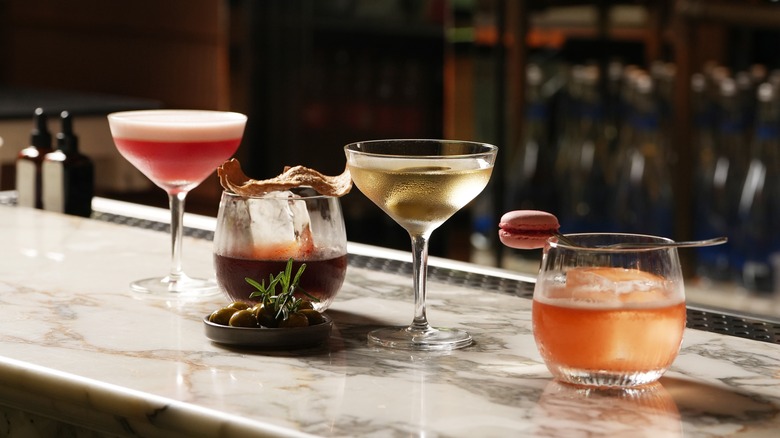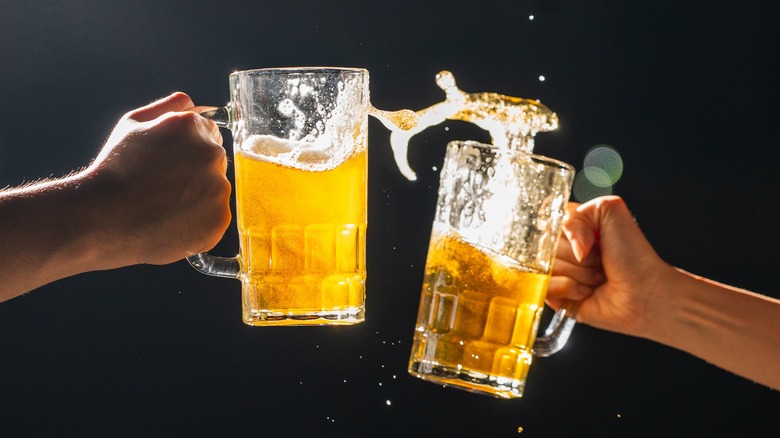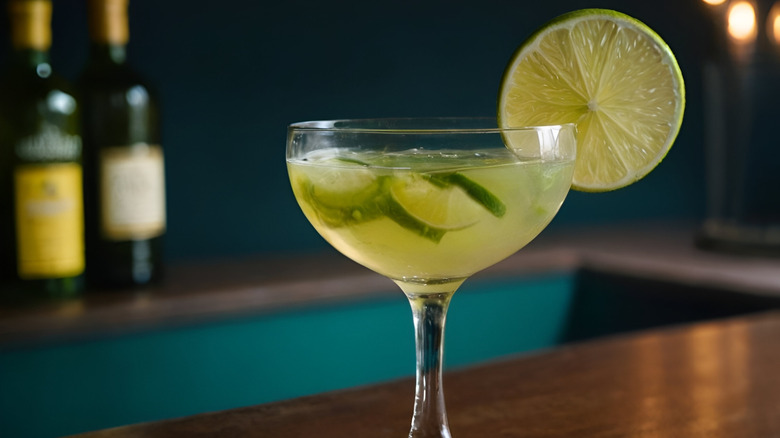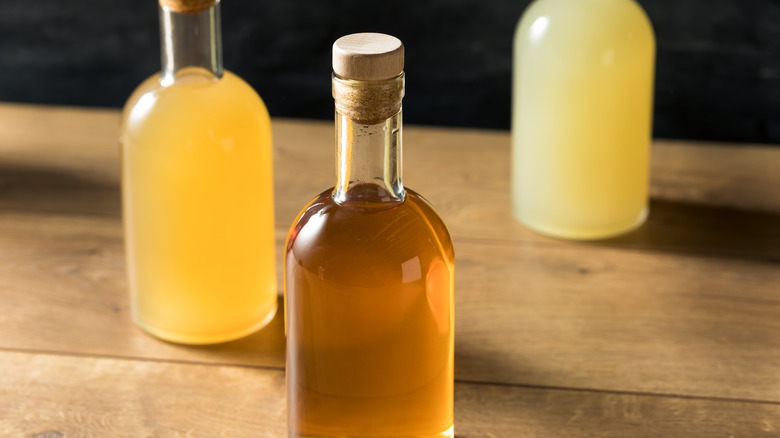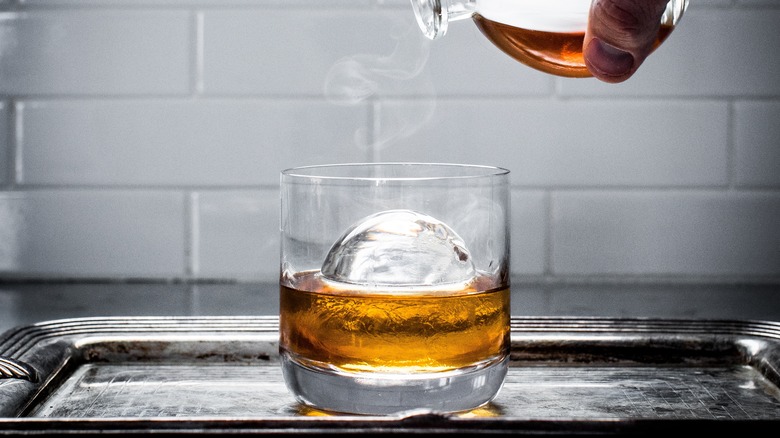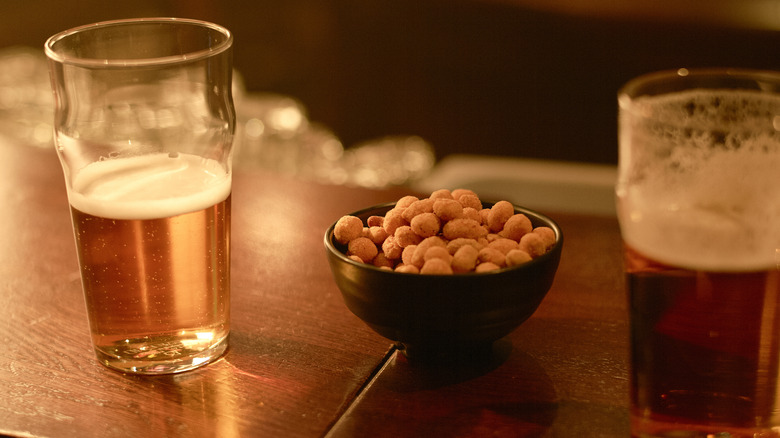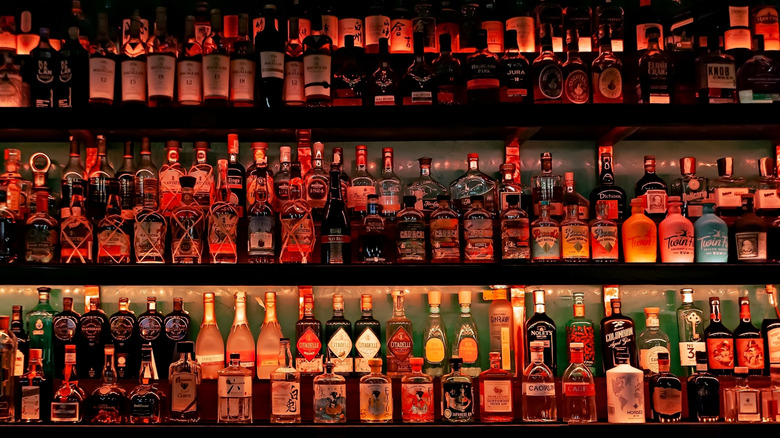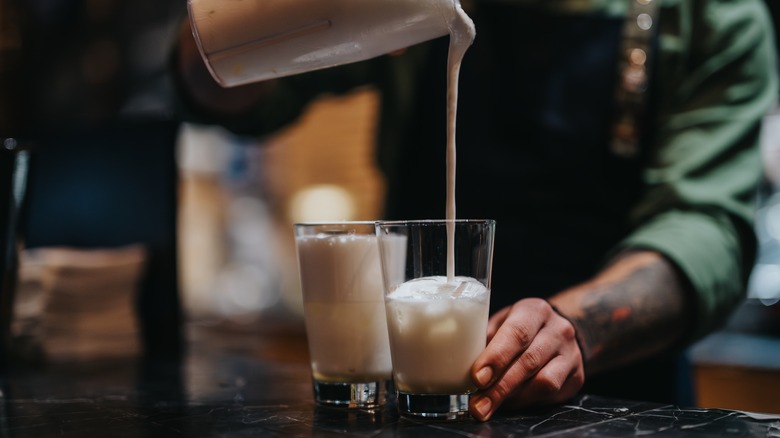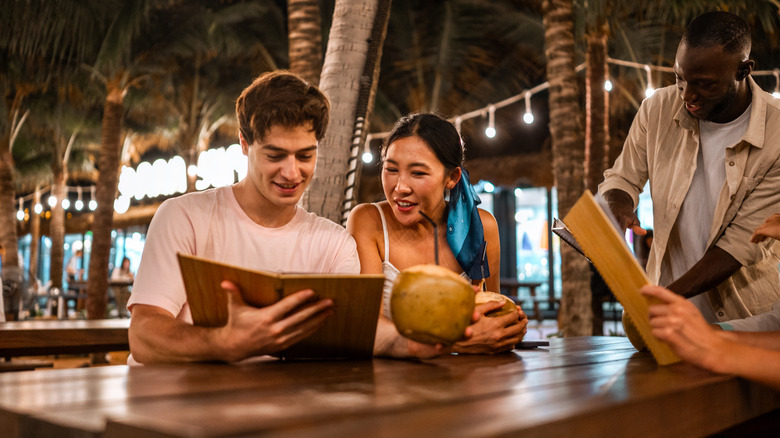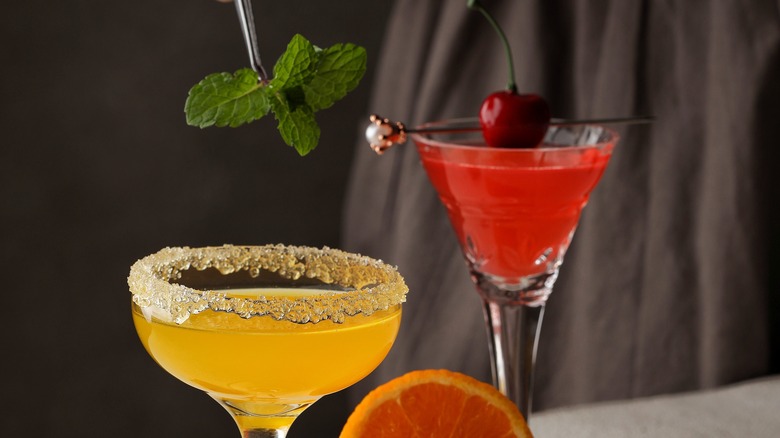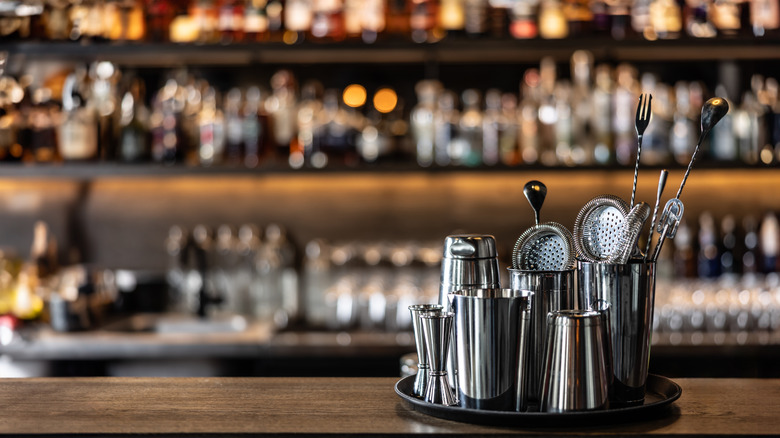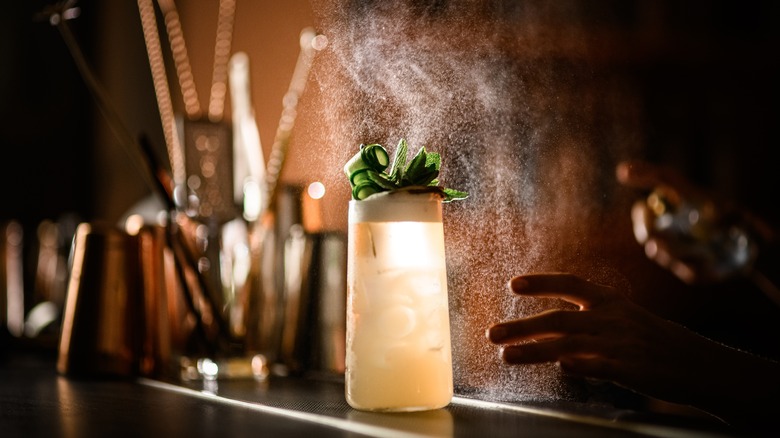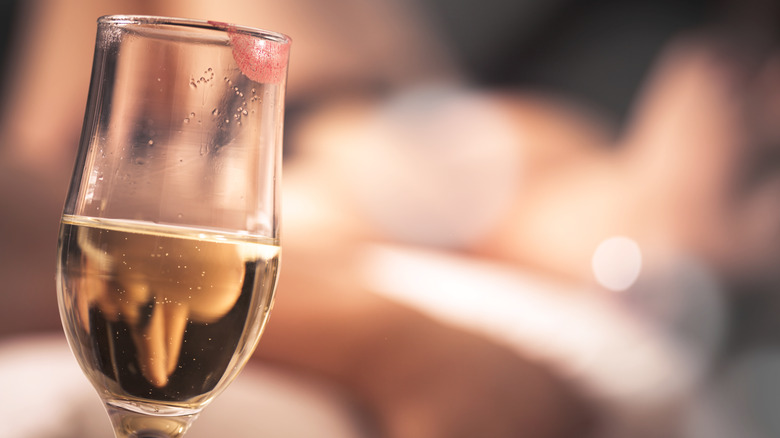13 Cocktail Bar Red Flags That Should Send You Running
If you're shelling out $18 or more for a cocktail, you're not just paying for a shot at a club or a beer at a sports bar — you're paying for mixology. That price tag should come with thoughtful flavor profiles, balanced acidity, and bartenders who know the difference between a jigger and a jello shot. When you're sipping something at that price, it's fair to expect more than just a shot of gin and a wilted sprig of mint. Most of the time, there are elevated mixology techniques involved, such as clarification, fermentation, or forced carbonation.
The cocktail renaissance has raised the bar (no pun intended), but it's also made it easier for places to fake the vibe. For those who care about quality, there are clear signs when a bar is phoning it in. Maybe it's the cloudy syrup, wilted herbs or the contaminated ice. Maybe the "craft cocktails" feature celebrity tequila. When you're paying for an experience, the red flags start to matter. If you're looking to avoid overpaying for a frat party punch, here are a few signs that the bar you're in might not be as top-shelf as its pricing suggests. Watch out for these and save your cocktail budget for somewhere that actually deserves it.
Sticky Floors
Sticky floors are not just gross. They're a sign that cleanliness isn't a priority, and that's a problem in a place that's serving things you're about to consume. A sticky floor can mean spilled drinks have been left to dry, syrup residue has built up over time, and worse, pests are usually not that far behind. It also suggests the bar isn't regularly mopped. While you don't need hospital-grade sanitation, a clean floor tells you that someone is paying attention to the details. If they're skipping basics like cleaning, what else are they skipping behind the bar or in the kitchen? This would make me think twice before ordering food ... or a drink.
Beyond the drinks, atmosphere is one of the key differences between a great cocktail bar and a local pub. A cocktail bar that gets this right is Overstory in New York City. With its immaculate interiors and pristine floors, the cleanliness sets the tone as soon as you arrive. It shows that they have thoughtfully considered every element of the environment to create an elevated cocktail experience.
Dirty Washrooms
Nobody expects a bathroom to be glamorous, but if it smells like a dive bar bathroom at 1 a.m., that's a red flag. A poorly maintained washroom suggests that hygiene isn't a house priority. If there's no soap, overflowing garbage, or suspicious puddles around the toilet, consider that foreshadowing for the rest of your experience. Clean washrooms often indicate attention to hygiene and good back-of-house habits. It also means they're more likely to wash their hands properly after handling garnishes, straining cocktails, or switching from cleaning to service. In fact, if the soap dispenser is sticky, crusted over, or empty, just leave. No drink is worth that gamble.
At the Michelin-starred Alo in Toronto, the restrooms are considered part of the experience. You'll find cloth towels, Le Lebo soap, and even a bathroom attendant that goes into the washroom to clean after each use. This signals refinement and reinforces its commitment to top-tier hospitality at every level of the guest experience.
Attention to Presentation
A fresh lemon twist or a mint sprig might seem small, but garnishes aren't just decoration, they are the aromatics of a cocktail. When garnishes are wilted or past their prime, they lose their aroma, structure, and visual appeal, which means your cocktail will not look or taste the way it should. High-end bars have strict systems in place: garnishes are prepped fresh, used once, and discarded even if untouched. Anything less is just cutting corners.
Cocktail consultant Steven Tseng (@tseng_stevenmix) also emphasizes that garnishes and straws should never be touched by hand. They should always be placed using tongs to avoid contamination. The care taken in how a drink is executed and served says a lot about the standards of the establishment.
Little Red Door in Paris is known for its on-point garnish game. Every leaf and edible flower is prepped with purpose, handled with care, and used only once. It's all part of its ingredient-led cocktail philosophy that treats garnishes not as flair, but as essential flavor components. They even have cocktail-making down to a science, going as far as listing the carbon footprint, brix, and acidity under drinks on the menu. Every detail is measured, thoughtful, and crafted to enhance the full experience from the first glance to the last sip.
Cocktail Mixes for Simple Drinks
Using cocktail mixes for complex tiki drinks or large batch clarified punches is one thing, but if your margarita, whiskey sour, or mojito is made with a neon green mix instead of fresh juice, that's a problem. Quality bars know the difference between cutting corners and smart prep. Prepped fresh juice, house-made syrups, and batched bases are totally acceptable, but commercial cocktail mixes with stabilizers, too much sugar, and artificial flavors don't belong in drinks that hinge on freshness. If a bar can't be bothered to juice a lime for your $21 cocktail, it's a flag that they shouldn't be charging $21.
A key difference between a cocktail bar and a pub is the quality of the drinks: the freshness, presentation, and complexity. Cocktail bars are for people who care about what is in the glass, drinking for taste rather than quantity. Sports bars, on the other hand, are built for volume, where speed and simplicity matter more than craftsmanship.
Led by mixology superstar, Eric van Beek, Handshake Speakeasy in Mexico City strikes the perfect balance between efficiency and integrity. Its team preps syrups, clarified punches, and juices in-house every day, and even their batched cocktails are carefully built for consistency without sacrificing quality. No matter how busy the night, each drink (including its mind-blowing piña colada) still tastes fresh, layered, and intentional, no shortcuts taken. With this level of quality, it's no surprise Handshake consistently dominates worldwide bar rankings.
Poor Ice Etiquette
Ice is not just frozen water. It affects dilution, temperature, and even the texture of your drink. If a bar only uses the same type of standard cubed ice for everything, it likely means they aren't taking the details seriously. Proper bars often have at least two types of ice: larger format cubes for spirit-forward cocktails and smaller ones for highballs or shaking. Some even go the extra mile with clear block ice, pebbled ice, or custom cuts. A one-size-fits-all approach is fine for house parties, but for cocktail bars, it's a missed opportunity to elevate the experience.
Additionally, Steven Tseng emphasizes that bartenders should always use ice scoops and avoid doing a "dirty dump," which means pouring the ice from the shaker directly into the finished cocktail. Shaker ice is often aerated, and slightly melted once it's been shaken which can lead to over-dilution resulting in a watery, uneven cocktail. Also, shaken ice can carry bits of fruit pulp, muddled mint, or residue that were never meant to end up in the final glass. Clean, fresh ice ensures that the drink stays crisp, cold, and properly balanced all the way through the last sip.
At Bar Benfiddich in Tokyo (No. 25 in World's Best Bar's ranking), the ice is an essential part of each drink. In fact, ice served here isn't just made of water — it includes infusions and aromatics that are intentionally paired with each cocktail. It's deliberate and carefully chosen to highlight the drink's structure.
Recycled Bar Snacks
If there's already a bowl of bar nuts on the table and it appears to be the same one from the last guest, run. Shared snacks that aren't replaced between patrons are a hygiene nightmare. Bars that reuse bar snacks are basically asking you to share a meal with strangers, germs and all. Even worse, some places quietly "top up" the bowl instead of starting fresh. It's a cost-saving move that tells you they are cutting corners in places they should not. Proper service means either offering individually portioned snacks or replacing shared bowls entirely for each new party. If a bar can't be trusted with peanuts, you might want to think twice about trusting them with perishables behind the bar.
Handshake Speakeasy in Mexico City, currently the top bar on the World's 50 Best Bars list, does this right. Upon arrival, each guest receives their own portion of warmed, individually served nuts, along with a warm towel for cleaning hands. This attention to detail acknowledges that guests may have come from the street and should not have to choose between hygiene and hospitality.
Non-Craft Spirits
There's nothing wrong with celebrity tequilas but when a bar describes itself as a "craft cocktail" destination then serves mass-produced spirits full of stabilizers, it feels like a bait and switch. The word "craft" should imply small-batch products and thoughtful sourcing. Bars that slap the word onto their signage while pouring vanilla-flavored tequilas and caramel-colored whiskies are using it as a marketing gimmick. If you ask your bartender for a recommendation and they push brands with flashy bottles, it's a red flag. Real craft bars are excited to tell you what makes their inventory special.
When Brenton Mowforth (@CheerstoHappyHour) spots interesting bottles that are not commonly found on the back bar, it signals the bar staff's passion and excitement for craft spirits. It shows they are curating their selection with intention and not just following trends. On the other hand, certain brands have built reputations on marketing than on actual quality. Seeing those bottles dominate the back bar usually lowers his expectations for what is about to be poured.
At Native in Singapore, craft means local and sustainably-sourced. Its bar program features regional gins, Indian whiskies, and even custom blends from its in-house fermentation lab. Every spirit choice is deliberate, and each ingredient's story is incorporated into its cocktail experience.
Bartenders Not Tasting Their Cocktails
Great bartenders taste as they go. It is not about sipping your drink — it is about quality control. Just like chefs taste their sauces, bartenders should be checking the balance of their cocktails before sending them out. If you notice your bartender never reaching for a tasting straw or seems surprised at how a drink turns out, that is a problem. Tasting ensures that ratios are right, citrus is fresh, and nothing was missed. It is especially important with more complex or stirred cocktails where flavor can vary slightly depending on dilution or temperature. Skipping this step usually means they are rushing or inexperienced. Either way, it can show in the final product.
At the award-winning Civil Liberties in Toronto, bartenders are trained to taste-test every drink served. Cocktail bar pioneer Nick Kennedy states that it's a non-negotiable part of its process, no matter how busy the bar gets. This relentlessness for perfection shows up in the consistent quality of every cocktail, earning it consistent top rankings in global best bars lists.
Menus with Over 100 Cocktails
A cocktail list longer than a brunch menu may seem impressive, but it is rarely a good sign. Bars that offer dozens of drinks often stretch themselves too thin. It is difficult to maintain good quality across that many recipes, especially if it includes hard-to-find ingredients or complicated prep. A bloated menu can also confuse customers and overwhelm staff, leading to longer wait times and sloppy execution. Great bars typically offer a tight, well-curated list with a mix of spirit-forward options, sours, and seasonal drinks. A concise menu usually signals that the team has tested and perfected what they are serving. If you want to explore beyond that, a skilled bartender will always have something off-menu to recommend.
The award-winning Double Chicken Please in New York City keeps its cocktail menu intentional. Each cocktail is built around a theme, like "Cold Pizza" or "Japanese Cold Noodle." The compact list allows for total precision in execution and storytelling. With a focused list and ultra-fresh ingredients, every cocktail feels deliberate, imaginative, and perfectly executed.
Civil Liberties in Toronto, ranked No. 21 on World's 50 Best Bars,has been proudly menu-free since 2014. Instead, the bartender asks what you are in the mood for and crafts a bespoke cocktail tailored to you. It feels effortless, but it's built on serious expertise and impeccable technique.
Lack of Freshness
Fresh ingredients are the backbone of a great cocktail. If your mint garnish is wilted, your basil is limp, or the simple syrup in the jar has turned cloudy, you are not getting the best the bar can offer. Herbs should be vibrant, not browning, and syrups should be clear or intentionally infused. Bars that don't pay attention to ingredient turnover are risking both flavor and safety. Spoiled or oxidized components can drastically affect the taste and mouthfeel of a drink. More importantly, it signals poor prep practices and lack of attention to detail. If they cannot keep the garnish fresh, you have to wonder how old the juice is.
A cocktail bar that truly champions fresh ingredients is Honey's in Brooklyn. Medicinal herbs are picked straight from their rooftop garden and cocktail shrubs are made fresh in-house, often flavored with local botanicals. Honey's also specializes in mead cocktails brewed right on-site, adding another layer of freshness you can actually taste.
Unorganized Bottles
A backbar should tell a story of the bar's taste and values, but if all you see are flashy bottles from celebrities or ultra-trendy TikTok brands, it might be time to lower your expectations. Bars that stock mostly hype brands tend to prioritize image over substance, which often spills over into the drinks themselves. There's nothing wrong with a few status-symbol spirits, but when they make up the entire section, it usually means your overpriced drink is paying for branding instead taste. A thoughtful bar shelf should include a mix of independent producers, niche spirits, and standout bottles like additive-free tequila.
The Connaught Bar in London is a perfect contrast. Its back bar is a shrine to global artistry, featuring rare vermouth, low-intervention spirits, and historic bottlings curated for both storytelling and complexity. There is no label here just for clout, every bottle has earned its place.
Carbonation Infractions
Carbonation is a key component in highballs and spritzes. When a bar uses a soda gun for soda on tap, you're getting cross-contaminated carbonation and a flat drink. Proper cocktail bars should either use bartender-approved bottled soda or a dedicated soda tap with clean, pressurized delivery. For an $21 cocktail, the difference in quality is obvious. Proper carbonation enhances mouthfeel and elevates even the simplest build. Bad soda water dulls the crispness of a drink and ruins the balance. If you see the bartender grabbing that multi-button soda gun, drink elsewhere.
At Mother Cocktail Bar in Toronto, carbonation is treated with the same precision as spirit selection, garnishes, and ice. Drinks are either carbonated using house-fermented bases, force carbonated, or finished with club soda poured from freshly opened bottles, never from a soda gun. Each method is intentional, dialed in to preserve flavor and deliver the perfect texture. The result is a highball that arrives crisp, velvety, and untainted by flat carbonation. When a bar pays this much attention to the bubbles, you can bet they're obsessing over every other element too.
Terrible Reviews for Basic Things
Bad reviews is a common red flag among bars and restaurants. Every bar will have an off night, but if a place consistently gets roasted in online reviews for things like bad service, watered-down drinks, or rude bartenders, it is worth taking seriously. Pay attention to common threads in complaints. If multiple reviewers mention poor hygiene, sloppy pours, or being served something that tasted off, that is more than just someone having a bad day. It reflects a pattern. The best bars welcome feedback and strive to improve. If management is defensive or dismissive in responses, that is another red flag. Before dropping $21 on a cocktail, a quick scan of reviews can save you from a disappointing night.
Licorería Limantour in Mexico City has a reputation for excellence that shows up both in rankings and guest reviews. From impeccable service to consistently well-balanced drinks, it is clear that feedback is taken seriously and used to refine the experience. A bar that listens is a bar worth revisiting.
Dirty or Worn-out Glassware
According to Brenton Mowforth (@CheerstoHappyHour), bad or out-of-date glassware is almost always an indication that drinks will be subpar. There's no faster way to kill a cocktail's vibe than serving it in a chipped coupe, a worn-out Collins glass, or a smudged highball. Cloudy glassware or soap residue can affect the aroma and taste of your drink. Worn glassware also runs the risk of cracking under temperature changes, especially when ice or carbonation is involved. A proper cocktail bar should treat its glassware like stemware in a fine dining room: polished, pristine, and free of blemishes.
A perfect cocktail deserves a perfect vessel. At a distinguished bar, each type of glass is chosen to highlight a cocktail's best qualities: coupes for delicate, spirit-forward sips, rocks glasses for bold stirred drinks like the Old Fashioned, and highballs for bubbly concoctions. If the glassware is scratched or the wrong size, the drink will never land the way it should.
Mother Cocktail Bar, led by cocktail visionary Massimo Zitti, handles this with precision. Every piece of glassware is hand-polished and checked for chips before it even hits the bar top. Its barbacks and bartenders treat each glass like it is part of the presentation. It is not just about cleanliness either, temperature matters too. Specific types of their glassware is stored refrigerated, ensuring that every cocktail is served at its ideal temperature from the very first sip.
